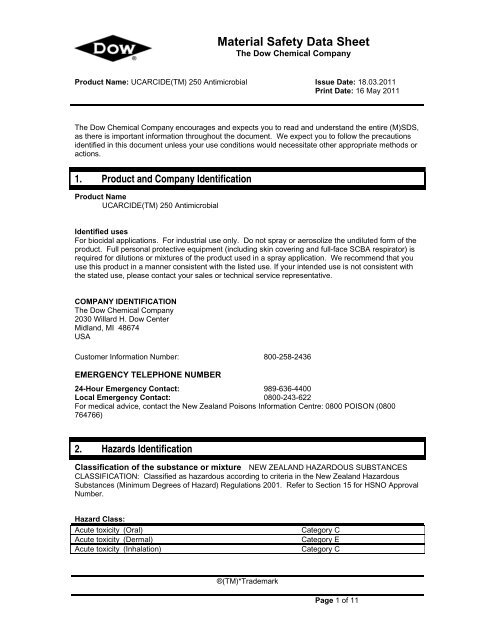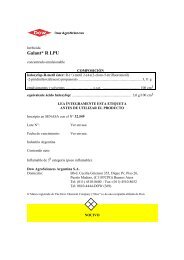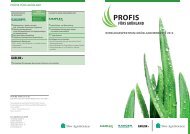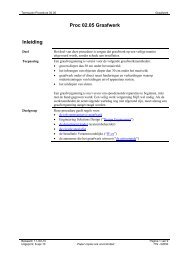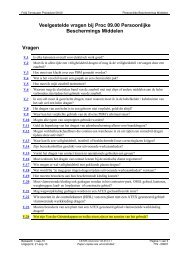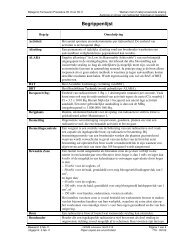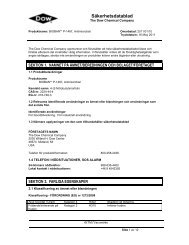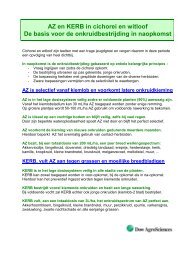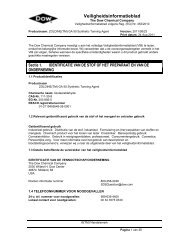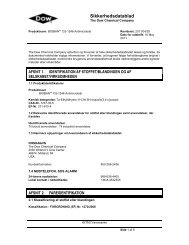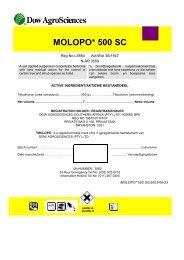Material Safety Data Sheet - The Dow Chemical Company
Material Safety Data Sheet - The Dow Chemical Company
Material Safety Data Sheet - The Dow Chemical Company
You also want an ePaper? Increase the reach of your titles
YUMPU automatically turns print PDFs into web optimized ePapers that Google loves.
Product Name: UCARCIDE(TM) 250 Antimicrobial Issue Date: 18.03.2011<br />
Print Date: 16 May 2011<br />
<strong>The</strong> <strong>Dow</strong> <strong>Chemical</strong> <strong>Company</strong> encourages and expects you to read and understand the entire (M)SDS,<br />
as there is important information throughout the document. We expect you to follow the precautions<br />
identified in this document unless your use conditions would necessitate other appropriate methods or<br />
actions.<br />
1. Product and <strong>Company</strong> Identification<br />
Product Name<br />
UCARCIDE(TM) 250 Antimicrobial<br />
Identified uses<br />
For biocidal applications. For industrial use only. Do not spray or aerosolize the undiluted form of the<br />
product. Full personal protective equipment (including skin covering and full-face SCBA respirator) is<br />
required for dilutions or mixtures of the product used in a spray application. We recommend that you<br />
use this product in a manner consistent with the listed use. If your intended use is not consistent with<br />
the stated use, please contact your sales or technical service representative.<br />
COMPANY IDENTIFICATION<br />
<strong>The</strong> <strong>Dow</strong> <strong>Chemical</strong> <strong>Company</strong><br />
2030 Willard H. <strong>Dow</strong> Center<br />
Midland, MI 48674<br />
USA<br />
Customer Information Number: 800-258-2436<br />
EMERGENCY TELEPHONE NUMBER<br />
24-Hour Emergency Contact: 989-636-4400<br />
Local Emergency Contact: 0800-243-622<br />
For medical advice, contact the New Zealand Poisons Information Centre: 0800 POISON (0800<br />
764766)<br />
2. Hazards Identification<br />
<strong>Material</strong> <strong>Safety</strong> <strong>Data</strong> <strong>Sheet</strong><br />
<strong>The</strong> <strong>Dow</strong> <strong>Chemical</strong> <strong>Company</strong><br />
Classification of the substance or mixture NEW ZEALAND HAZARDOUS SUBSTANCES<br />
CLASSIFICATION: Classified as hazardous according to criteria in the New Zealand Hazardous<br />
Substances (Minimum Degrees of Hazard) Regulations 2001. Refer to Section 15 for HSNO Approval<br />
Number.<br />
Hazard Class:<br />
Acute toxicity (Oral) Category C<br />
Acute toxicity (Dermal) Category E<br />
Acute toxicity (Inhalation) Category C<br />
®(TM)*Trademark<br />
Page 1 of 11
Product Name: UCARCIDE(TM) 250 Antimicrobial Issue Date: 18.03.2011<br />
Respiratory sensitization Category A<br />
Skin sensitization Category B<br />
Acute toxicity (Inhalation) (Respiratory tract irritant.) Category E<br />
Skin corrosion Category B<br />
Aquatic toxicity (Acute or Chronic) Category A<br />
Label elements<br />
Hazard Symbol:<br />
Signal Word: Danger<br />
Hazards of product:<br />
Toxic if swallowed.<br />
Toxic if inhaled.<br />
May be harmful in contact with skin.<br />
Causes severe skin burns and eye damage.<br />
May cause allergy or asthma symptoms or breathing difficulties if inhaled.<br />
May cause an allergic skin reaction.<br />
May cause respiratory irritation.<br />
Very toxic to aquatic life.<br />
Precautionary Statements:<br />
Prevention: Do not breathe dust/ fume/ gas/ mist/ vapours/ spray. Wear protective gloves/<br />
protective clothing/ eye protection/ face protection. In case of inadequate ventilation wear<br />
respiratory protection. Avoid release to the environment.<br />
Response: IF SWALLOWED: rinse mouth. Do NOT induce vomiting. IF INHALED: Remove<br />
victim to fresh air and keep at rest in a position comfortable for breathing. IF ON SKIN (or<br />
hair): Remove/ Take off immediately all contaminated clothing. Rinse skin with water/ shower.<br />
IF IN EYES: Rinse cautiously with water for several minutes. Remove contact lenses, if<br />
present and easy to do. Continue rinsing.<br />
Storage: Store in a well-ventilated place. Keep container tightly closed.<br />
Transport Information: Hazard Class: 8 (6.1) ID Number: UN2922 Packing Group: II<br />
3. Composition Information<br />
Component CAS # Amount<br />
Glutaraldehyde 111-30-8 50.0 %<br />
Water 7732-18-5
Product Name: UCARCIDE(TM) 250 Antimicrobial Issue Date: 18.03.2011<br />
Skin Contact: Take off contaminated clothing. Wash skin with soap and plenty of water for 15-20<br />
minutes. Call a poison control center or doctor for treatment advice. Wash clothing before reuse.<br />
Shoes and other leather items which cannot be decontaminated should be disposed of properly.<br />
Suitable emergency safety shower facility should be immediately available.<br />
Eye Contact: Wash immediately and continuously with flowing water for at least 30 minutes. Remove<br />
contact lenses after the first 5 minutes and continue washing. Obtain prompt medical consultation,<br />
preferably from an ophthalmologist. Suitable emergency eye wash facility should be immediately<br />
available.<br />
Ingestion: If the person is fully alert and cooperative, have the person rinse mouth with plenty of<br />
water. In cases of ingestion have the person drink 4 to 10 ounces (120-300 mL) of water. Do not<br />
induce vomiting. Do not attempt mouth rinse if the person has respiratory distress, altered mental<br />
status, or nausea and vomiting. Call a physician and/or transport to emergency facility immediately.<br />
See "Indication of immediate medical attention and special treatment needed". Seek medical attention<br />
immediately.<br />
Most important symptoms and effects, both acute and delayed<br />
Aside from the information found under Description of first aid measures (above) and Indication of<br />
immediate medical attention and special treatment needed (below), no additional symptoms and<br />
effects are anticipated.<br />
Indication of immediate medical attention and special treatment needed<br />
Maintain adequate ventilation and oxygenation of the patient. May cause respiratory sensitization or<br />
asthma-like symptoms. Bronchodilators, expectorants and antitussives may be of help.<br />
Glutaraldehyde may transiently worsen reversible airways obstruction including asthma or reactive<br />
airways disease. Treat bronchospasm with inhaled beta2 agonist and oral or parenteral<br />
corticosteroids. <strong>Chemical</strong> eye burns may require extended irrigation. Obtain prompt consultation,<br />
preferably from an ophthalmologist. If burn is present, treat as any thermal burn, after<br />
decontamination. Due to irritant properties, swallowing may result in burns/ulceration of mouth,<br />
stomach and lower gastrointestinal tract with subsequent stricture. Aspiration of vomitus may cause<br />
lung injury. Suggest endotracheal/esophageal control if lavage is done. Probable mucosal damage<br />
may contraindicate the use of gastric lavage. Inhalation of vapors may result in skin sensitization. In<br />
sensitized individuals, reexposure to very small amounts of vapor, mist, or liquid may cause a severe<br />
allergic skin reaction. No specific antidote. Treatment of exposure should be directed at the control of<br />
symptoms and the clinical condition of the patient. Have the <strong>Safety</strong> <strong>Data</strong> <strong>Sheet</strong>, and if available, the<br />
product container or label with you when calling a poison control center or doctor, or going for<br />
treatment.<br />
Excessive exposure may aggravate preexisting asthma and other respiratory disorders (e.g.<br />
emphysema, bronchitis, reactive airways dysfunction syndrome).<br />
5. Fire Fighting Measures<br />
Suitable extinguishing media<br />
To extinguish combustible residues of this product use water fog, carbon dioxide, dry chemical or<br />
foam.<br />
Special hazards arising from the substance or mixture<br />
Hazardous Combustion Products: Under fire conditions some components of this product may<br />
decompose. <strong>The</strong> smoke may contain unidentified toxic and/or irritating compounds. Combustion<br />
products may include and are not limited to: Carbon monoxide. Carbon dioxide.<br />
Unusual Fire and Explosion Hazards: This material will not burn until the water has evaporated.<br />
Residue can burn.<br />
Advice for firefighters<br />
Fire Fighting Procedures: Keep people away. Isolate fire and deny unnecessary entry. To<br />
extinguish combustible residues of this product use water fog, carbon dioxide, dry chemical or foam.<br />
Page 3 of 11
Product Name: UCARCIDE(TM) 250 Antimicrobial Issue Date: 18.03.2011<br />
Contain fire water run-off if possible. Fire water run-off, if not contained, may cause environmental<br />
damage. Review the "Accidental Release Measures" and the "Ecological Information" sections of this<br />
(M)SDS.<br />
Special Protective Equipment for Firefighters: Wear positive-pressure self-contained breathing<br />
apparatus (SCBA) and protective fire fighting clothing (includes fire fighting helmet, coat, trousers,<br />
boots, and gloves). Avoid contact with this material during fire fighting operations. If contact is likely,<br />
change to full chemical resistant fire fighting clothing with self-contained breathing apparatus. If this is<br />
not available, wear full chemical resistant clothing with self-contained breathing apparatus and fight fire<br />
from a remote location. For protective equipment in post-fire or non-fire clean-up situations, refer to<br />
the relevant sections.<br />
See Section 9 for related Physical Properties<br />
6. Accidental Release Measures<br />
Personal precautions, protective equipment and emergency procedures: Use appropriate safety<br />
equipment. For additional information, refer to Section 8, Exposure Controls and Personal Protection.<br />
Evacuate area. Keep upwind of spill. Ventilate area of leak or spill. Only trained and properly<br />
protected personnel must be involved in clean-up operations. Refer to Section 7, Handling, for<br />
additional precautionary measures.<br />
Environmental precautions: Spills or discharge to natural waterways is likely to kill aquatic<br />
organisms. Prevent from entering into soil, ditches, sewers, waterways and/or groundwater. See<br />
Section 12, Ecological Information.<br />
Methods and materials for containment and cleaning up: Avoid making contact with spilled<br />
material, glutaraldehyde will be absorbed by most shoes. Always wear the correct protective<br />
equipment, consisting of splashproof monogoggles, or both safety glasses with side shields and a<br />
wraparound full-face shield, appropriate gloves and protective clothing. A self-contained breathing<br />
apparatus or respirator and absorbents may be necessary, depending on the size of the spill and the<br />
adequacy of ventilation. Small spills: Wear the correct protective equipment and cover the liquid with<br />
absorbent material. Collect and seal the material and the dirt that has absorbed the spilled material in<br />
polyethylene bags and place in a drum for transit to an approved disposal site. Rinse away the<br />
remaining spilled material with water to reduce odor, and discharge the rinsate into a municipal or<br />
industrial sewer. Large spills: In case of nasal and respiratory irritation, vacate the room immediately.<br />
Personnel cleaning up should be trained and equipped with a self-contained breathing apparatus, or<br />
an officially approved or certified full-face respirator equipped with an organic vapor cartridge, gloves,<br />
and clothing impervious to glutaraldehyde, including rubber boots or shoe protection. Deactivate with<br />
sodium bisulfite (2-3 parts (by weight) per part of active substance glutaraldehyde), collect the<br />
neutralized liquid and place in a drum for transit to an approved disposal site.<br />
7. Handling and Storage<br />
Handling<br />
General Handling: Do not get in eyes, on skin, on clothing. Avoid breathing vapor. Do not swallow.<br />
Keep container closed. Use with adequate ventilation. Wear goggles, protective clothing and butyl or<br />
nitrile gloves. Wash thoroughly with soap and water after handling. Remove contaminated clothing<br />
and wash before reuse.<br />
Other Precautions: Do not spray or aerosolize the undiluted form of the product. Full personal<br />
protective equipment (including skin covering and full-face SCBA respirator) is required for dilutions or<br />
mixtures of the product used in a spray application.<br />
Storage<br />
Do not store in: Aluminum. Carbon steel. Copper. Mild steel. Iron. Please refer to <strong>Dow</strong> publication:<br />
GLUTARALDEHYDE. Safe Handling and Storage Guide; Form No. 253-01338.<br />
Shelf life: Use within 12 Months<br />
Page 4 of 11
Product Name: UCARCIDE(TM) 250 Antimicrobial Issue Date: 18.03.2011<br />
8. Exposure Controls / Personal Protection<br />
Exposure Limits<br />
Component List Type Value<br />
|<br />
Glutaraldehyde ACGIH Ceiling 0.05 ppm SEN<br />
NZ OEL STEL 0.05 ppm SEN<br />
|<br />
Methanol ACGIH TWA 200 ppm SKIN, BEI<br />
ACGIH STEL 250 ppm SKIN, BEI<br />
NZ OEL TWA 262 mg/m3 200 ppm SKIN, BEI<br />
NZ OEL STEL 328 mg/m3 250 ppm SKIN, BEI<br />
A BEI notation following the exposure guideline refers to a guidance value for assessing biological<br />
monitoring results as an indicator of the uptake of a substance from all routes of exposures.<br />
A "skin" notation following the inhalation exposure guideline refers to the potential for dermal<br />
absorption of the material including mucous membranes and the eyes either by contact with vapors or<br />
by direct skin contact.<br />
It is intended to alert the reader that inhalation may not be the only route of exposure and that<br />
measures to minimize dermal exposures should be considered.<br />
A "SEN" notation following the exposure guideline refers to the potential to produce sensitization, as<br />
confirmed by human or animal data.<br />
Personal Protection<br />
Eye/Face Protection: Use chemical goggles. If exposure causes eye discomfort, use a full-face<br />
respirator. Use a full-face respirator when material is heated or when aerosols/mists are generated.<br />
Eye wash fountain should be located in immediate work area.<br />
Skin Protection: Use protective clothing chemically resistant to this material. Selection of specific<br />
items such as face shield, boots, apron, or full body suit will depend on the task. <strong>Safety</strong> shower should<br />
be located in immediate work area. Use chemical protective clothing resistant to this material, when<br />
there is any possibility of skin contact. Remove contaminated clothing immediately, wash skin area<br />
with soap and water, and launder clothing before reuse or dispose of properly. Items which cannot be<br />
decontaminated, such as shoes, belts and watchbands, should be removed and disposed of properly.<br />
Hand protection: Use gloves, chemically resistant to this material, at all times. Use chemical<br />
resistant gloves classified under standard AS/NZS 2161.10: Protective gloves against<br />
chemicals and micro-organisms. Examples of preferred glove barrier materials include: Butyl<br />
rubber. Examples of acceptable glove barrier materials include: Nitrile/butadiene rubber<br />
("nitrile" or "NBR"). When prolonged or frequently repeated contact may occur, a glove with a<br />
protection class of 6 or higher (breakthrough time greater than 480 minutes according to<br />
AS/NZS 2161.10) is recommended. When only brief contact is expected, a glove with a<br />
protection class of 3 or higher (breakthrough time greater than 60 minutes according to<br />
AS/NZS 2161.10) is recommended. NOTICE: <strong>The</strong> selection of a specific glove for a particular<br />
application and duration of use in a workplace should also take into account all relevant<br />
workplace factors such as, but not limited to: Other chemicals which may be handled, physical<br />
requirements (cut/puncture protection, dexterity, thermal protection), potential body reactions<br />
to glove materials, as well as the instructions/specifications provided by the glove supplier.<br />
Respiratory Protection: Atmospheric levels should be maintained below the exposure guideline.<br />
When respiratory protection is required for certain operations, use an approved air-purifying respirator.<br />
This product is a respiratory irritant. If discomfort is experienced ventilation is not adequate and an<br />
approved full face air-purifying respirator is recommended. If vapors are strong enough to be irritating<br />
to the nose, or eyes, the OEL is probably being exceeded. Special ventilation or respiratory protection<br />
may be required. For operations such as spraying and other conditions such as emergencies where<br />
the exposure guideline may be greatly exceeded, use an approved positive-pressure self-contained<br />
breathing apparatus. For emergency response or for situations where the atmospheric level is<br />
unknown, use an approved positive-pressure self-contained breathing apparatus or positive-pressure<br />
air line with auxiliary self-contained air supply. <strong>The</strong> following should be effective types of air-purifying<br />
respirators: Full-face Organic vapor cartridge with a particulate pre-filter.<br />
Page 5 of 11
Product Name: UCARCIDE(TM) 250 Antimicrobial Issue Date: 18.03.2011<br />
Ingestion: Avoid ingestion of even very small amounts; do not consume or store food or tobacco in<br />
the work area; wash hands and face before smoking or eating.<br />
Engineering Controls<br />
Ventilation: Use engineering controls to maintain airborne level below exposure limit requirements or<br />
guidelines. If there are no applicable exposure limit requirements or guidelines, use only with<br />
adequate ventilation. Local exhaust ventilation may be necessary for some operations.<br />
Other Information<br />
Selection and use of personal protective equipment should be in accordance with the<br />
recommendations in one or more of the relevant Australian/New Zealand Standards, including:<br />
AS/NZS 1336: Recommended practices for eye protection in the industrial environment.<br />
AS/NZS 1337: Eye protectors for industrial applications.<br />
AS/NZS 1715: Selection, use and maintenance of respiratory protective devices.<br />
AS/NZS 2161: Occupational protective gloves.<br />
AS/NZS 2210: Occupational protective footwear.<br />
AS 2919: Industrial clothing.<br />
9. Physical and <strong>Chemical</strong> Properties<br />
Appearance<br />
Physical State Liquid.<br />
Color Clear<br />
Odor Fruity<br />
Odor Threshold < 1 ppb Literature<br />
pH 3.1 - 4.5 ASTM E70<br />
Melting Point Not applicable to liquids<br />
Freezing Point -18 °C OECD 102<br />
Boiling Point (760 mmHg) 100.7 °C OECD 103 .<br />
Flash Point - Closed Cup ASTM D56 (none)<br />
Evaporation Rate (Butyl 1.0 Literature<br />
Acetate = 1)<br />
Flammability (solid, gas) No<br />
Flammable Limits In Air Lower: No test data available<br />
Upper: No test data available<br />
Vapor Pressure 0.3 mmHg @ 20 °C OECD 104 Active ingredient<br />
Vapor Density (air = 1) 1.1 Literature<br />
Specific Gravity (H2O = 1) 1.129 OECD 109<br />
Solubility in water (by<br />
weight)<br />
100 % @ 20 °C Calculated<br />
Partition coefficient, noctanol/water<br />
(log Pow)<br />
-0.333 Measured<br />
Autoignition Temperature No test data available<br />
Decomposition<br />
No test data available<br />
Temperature<br />
Dynamic Viscosity 15.4 cps @ 25 °C (Brookfield Viscosity - @ 100 rpm, #0 spindle)<br />
Kinematic Viscosity 20.2 mm2/s @ 20 °C Literature<br />
Explosive properties no data available<br />
Oxidizing properties No<br />
Henry's Law Constant (H) 3.3E-08 atm*m3/mole; 25 °C Measured<br />
10. Stability and Reactivity<br />
Reactivity<br />
No dangerous reaction known under conditions of normal use.<br />
Page 6 of 11
Product Name: UCARCIDE(TM) 250 Antimicrobial Issue Date: 18.03.2011<br />
<strong>Chemical</strong> stability<br />
<strong>The</strong>rmally stable at typical use temperatures.<br />
Possibility of hazardous reactions<br />
Polymerization will not occur.<br />
Conditions to Avoid: Active ingredient decomposes at elevated temperatures.<br />
Incompatible <strong>Material</strong>s: Avoid contact with: Amines. Ammonia. Strong acids. Strong bases.<br />
Strong oxidizers. Avoid contact with metals such as: Aluminum. Carbon steel. Copper. Iron. Mild<br />
steel.<br />
Hazardous decomposition products<br />
Decomposition products depend upon temperature, air supply and the presence of other materials.<br />
11. Toxicological Information<br />
Acute Toxicity<br />
Ingestion<br />
May be fatal if swallowed. Swallowing may result in irritation or burns of the mouth, throat, and<br />
gastrointestinal tract. Swallowing may result in gastrointestinal irritation or ulceration. Excessive<br />
exposure may cause: Headache. Dizziness. Anesthetic effects. Drowsiness. Unconsciousness.<br />
Other central nervous system effects.<br />
As product: LD50, Rat, male and female 200 mg/kg<br />
Aspiration hazard<br />
Aspiration into the lungs may occur during ingestion or vomiting, causing tissue damage or lung injury.<br />
Dermal<br />
May be fatal if absorbed through skin.<br />
As product: LD50, Rabbit, male 1,749 mg/kg<br />
Inhalation<br />
Vapor may cause severe irritation of the upper respiratory tract (nose and throat). Vapor from heated<br />
material may cause serious adverse effects, even death. Case reports and medical surveys link<br />
asthma and respiratory irritation to glutaraldehyde exposure, primarily in medical personnel. Asthmalike<br />
symptoms may occur in people prone to respiratory disorders or other allergies. Asthma-like<br />
symptoms may include coughing, difficult breathing and a feeling of tightness in the chest.<br />
Occasionally, breathing difficulties may be life threatening.<br />
As product: <strong>The</strong> LC50 has not been determined.<br />
Eye damage/eye irritation<br />
May cause severe irritation with corneal injury which may result in permanent impairment of vision,<br />
even blindness. <strong>Chemical</strong> burns may occur. Vapor may cause eye irritation experienced as mild<br />
discomfort and redness.<br />
Skin corrosion/irritation<br />
Brief contact may cause skin irritation with local redness. Prolonged contact may cause severe skin<br />
burns. Symptoms may include pain, severe local redness, swelling, and tissue damage. May stain<br />
skin. May cause itching.<br />
Sensitization<br />
Skin<br />
Skin contact may cause an allergic skin reaction in a small proportion of individuals. Has caused<br />
allergic skin reactions when tested in guinea pigs. Has demonstrated the potential for contact allergy<br />
in mice.<br />
Respiratory<br />
May cause allergic respiratory response in a small proportion of individuals.<br />
Repeated Dose Toxicity<br />
Repeated skin contact may result in absorption of amounts which could cause death. May cause<br />
nausea and vomiting.<br />
Chronic Toxicity and Carcinogenicity<br />
In a NTP chronic 2-year inhalation study on glutaraldehyde, no carcinogenicity was seen in rats or in<br />
mice. An increase in large granular lymphocytes in Fischer rats dosed with glutaraldehyde for two<br />
Page 7 of 11
Product Name: UCARCIDE(TM) 250 Antimicrobial Issue Date: 18.03.2011<br />
years was random or a secondary carcinogenic effect due to a modifying influence on the occurrence<br />
of this common neoplasm in this rat strain.<br />
Developmental Toxicity<br />
Has been toxic to the fetus in laboratory animals at doses toxic to the mother. Did not cause birth<br />
defects in laboratory animals.<br />
Reproductive Toxicity<br />
In animal studies, did not interfere with reproduction.<br />
Genetic Toxicology<br />
In vitro genetic toxicity studies were negative in some cases and positive in other cases. Animal<br />
genetic toxicity studies were predominantly negative.<br />
Component Toxicology - Methanol<br />
Inhalation LC50, 4 h, Rat 83.8 mg/l<br />
12. Ecological Information<br />
Toxicity<br />
<strong>Material</strong> is highly toxic to aquatic organisms on an acute basis (LC50/EC50 between 0.1 and 1 mg/L in<br />
the most sensitive species tested). <strong>Material</strong> is moderately toxic to birds on an acute basis (LD50<br />
between 51 and 500 mg/kg). <strong>Material</strong> is practically non-toxic to birds on a dietary basis (LC50 > 5000<br />
ppm).<br />
Fish Acute & Prolonged Toxicity<br />
LC50, fathead minnow (Pimephales promelas), 96 h: 10.8 mg/l<br />
Aquatic Invertebrate Acute Toxicity<br />
LC50, water flea Daphnia magna, 48 h, immobilization: 0.69 mg/l<br />
Aquatic Plant Toxicity<br />
EbC50, green alga Pseudokirchneriella subcapitata (formerly known as Selenastrum capricornutum),<br />
biomass growth inhibition, 72 h: 2.64 mg/l<br />
Toxicity to Micro-organisms<br />
EC50, OECD 209 Test; activated sludge: > 50 mg/l<br />
EC50; bacteria, 16 h: 17 - 25 mg/l<br />
Toxicity to Above Ground Organisms<br />
oral LD50, mallard (Anas platyrhynchos): 408 - 466 mg/kg<br />
dietary LC50, bobwhite (Colinus virginianus): > 5,000 ppm<br />
dietary LC50, mallard (Anas platyrhynchos): > 5,000 ppm<br />
Persistence and Degradability<br />
<strong>Material</strong> is readily biodegradable. Passes OECD test(s) for ready biodegradability.<br />
OECD Biodegradation Tests:<br />
Biodegradation Exposure Time Method 10 Day Window<br />
83 % 28 d OECD 301A Test pass<br />
73 % 28 d OECD 306 Test Not applicable<br />
Indirect Photodegradation with OH Radicals<br />
Rate Constant Atmospheric Half-life Method<br />
4.69E-11 cm3/s 2.74 h Estimated.<br />
Bioaccumulative potential<br />
Bioaccumulation: Bioconcentration potential is low (BCF < 100 or Log Pow < 3).<br />
Partition coefficient, n-octanol/water (log Pow): -0.333 Measured<br />
Mobility in soil<br />
Mobility in soil: Potential for mobility in soil is high (Koc between 50 and 150)., Given its very low<br />
Henry's constant, volatilization from natural bodies of water or moist soil is not expected to be an<br />
important fate process.<br />
Page 8 of 11
Product Name: UCARCIDE(TM) 250 Antimicrobial Issue Date: 18.03.2011<br />
Partition coefficient, soil organic carbon/water (Koc): 120 - 500 Estimated.<br />
Henry's Law Constant (H): 3.3E-08 atm*m3/mole; 25 °C Measured<br />
Results of PBT and vPvB assessment<br />
This substance is not considered to be persistent, bioaccumulating and toxic (PBT). This substance is<br />
not considered to be very persistent and very bioaccumulating (vPvB).<br />
Other adverse effects<br />
This substance is not in Annex I of Regulation (EC) 2037/2000 on substances that deplete the ozone<br />
layer.<br />
13. Disposal Considerations<br />
Disposal methods<br />
DO NOT DUMP INTO ANY SEWERS, ON THE GROUND, OR INTO ANY BODY OF WATER. All<br />
disposal practices must be in compliance with all Federal, State/Provincial and local laws and<br />
regulations. Regulations may vary in different locations. Waste characterizations and compliance with<br />
applicable laws are the responsibility solely of the waste generator. AS YOUR SUPPLIER, WE HAVE<br />
NO CONTROL OVER THE MANAGEMENT PRACTICES OR MANUFACTURING PROCESSES OF<br />
PARTIES HANDLING OR USING THIS MATERIAL. THE INFORMATION PRESENTED HERE<br />
PERTAINS ONLY TO THE PRODUCT AS SHIPPED IN ITS INTENDED CONDITION AS<br />
DESCRIBED IN MSDS SECTION: Composition Information. FOR UNUSED & UNCONTAMINATED<br />
PRODUCT, the preferred option is to contact your State Pesticide or Environmental Control Agency, or<br />
the Hazardous Waste representative at the nearest EPA Regional Office for guidance. <strong>The</strong> preferred<br />
option in other jurisdictions is to contact the regulatory authority for this product for guidance.<br />
Waste handling, treatment and disposal practices must be in compliance with the New Zealand<br />
Hazardous Substances (Disposal) Regulations 2001. Additional local requirements may be applicable<br />
in accordance with planning controls under the Resource Management Act. Regulations concerning<br />
waste management may vary in different locations.<br />
This product when disposed of in its unused and uncontaminated state should be treated as a<br />
hazardous waste.<br />
14. Transport Information<br />
ROAD & RAIL<br />
Proper Shipping Name: CORROSIVE LIQUID, TOXIC, N.O.S.<br />
Technical Name: GLUTARALDEHYDE<br />
Hazard Class: 8 (6.1) ID Number: UN2922 Packing Group: PG II<br />
IMDG<br />
Proper Shipping Name: CORROSIVE LIQUID, TOXIC, N.O.S.<br />
Technical Name: GLUTARALDEHYDE<br />
Hazard Class: 8 (6.1) ID Number: UN2922 Packing Group: PG II<br />
EMS Number: F-A,S-B<br />
Marine pollutant.: Yes<br />
ICAO/IATA<br />
Proper Shipping Name: CORROSIVE LIQUID, TOXIC, N.O.S.<br />
Technical Name: GLUTARALDEHYDE<br />
Hazard Class: 8 (6.1) ID Number: UN2922 Packing Group: PG II<br />
Cargo Packing Instruction: 855<br />
Passenger Packing Instruction: 851<br />
HAZCHEM CODE: 2X<br />
Page 9 of 11
Product Name: UCARCIDE(TM) 250 Antimicrobial Issue Date: 18.03.2011<br />
This information is not intended to convey all specific regulatory or operational<br />
requirements/information relating to this product. Additional transportation system information can be<br />
obtained through an authorized sales or customer service representative. It is the responsibility of the<br />
transporting organization to follow all applicable laws, regulations and rules relating to the<br />
transportation of the material.<br />
15. Regulatory Information<br />
New Zealand. Inventory of <strong>Chemical</strong>s (NZIoC), as published by ERMA New Zealand<br />
<strong>The</strong> hazardous components of this product are listed in the New Zealand Inventory of <strong>Chemical</strong>s<br />
(NZIoC) or the product otherwise complies with the requirements of the Hazardous Substances and<br />
New Organisms (HSNO) Act 1996.<br />
HSNO Approval Number<br />
HSR002510<br />
Group Standard Name<br />
Additives, Process <strong>Chemical</strong>s and Raw <strong>Material</strong>s (Toxic [6.1], Corrosive) Group Standard 2006<br />
ADVICE TO PRODUCT USERS REGARDING HSNO CONTROLS: Users of this product should make<br />
reference to the New Zealand Hazardous Substances and New Organisms Act and Regulations for<br />
relevant risk management controls. Additional local requirements may be applicable in accordance<br />
with planning controls under the Resource Management Act. Refer Environment Risk Management<br />
Authority publications (1) ER-UG-05-1 11/01 User Guide for HSNO Controls; and (2) ER-QG-31-1<br />
Group Standards Quick Guide available from the web site http://www.ermanz.govt.nz/hs/index.html<br />
16. Other Information<br />
Product Literature<br />
Additional information on this product may be obtained by calling your sales or customer service<br />
contact.<br />
Revision<br />
Identification Number: 1967 / 0000 / Issue Date 18.03.2011 / Version: 4.0<br />
Most recent revision(s) are noted by the bold, double bars in left-hand margin throughout this<br />
document.<br />
Legend<br />
N/A Not available<br />
W/W Weight/Weight<br />
OEL Occupational Exposure Limit<br />
STEL Short Term Exposure Limit<br />
TWA Time Weighted Average<br />
ACGIH American Conference of Governmental Industrial Hygienists, Inc.<br />
DOW IHG <strong>Dow</strong> Industrial Hygiene Guideline<br />
WEEL Workplace Environmental Exposure Level<br />
HAZ_DES Hazard Designation<br />
<strong>The</strong> <strong>Dow</strong> <strong>Chemical</strong> <strong>Company</strong> urges each customer or recipient of this (M)SDS to study it carefully and<br />
consult appropriate expertise, as necessary or appropriate, to become aware of and understand the<br />
data contained in this (M)SDS and any hazards associated with the product. <strong>The</strong> information herein is<br />
provided in good faith and believed to be accurate as of the effective date shown above. However, no<br />
warranty, express or implied, is given. Regulatory requirements are subject to change and may differ<br />
between various locations. It is the buyer's/user's responsibility to ensure that his activities comply with<br />
all federal, state, provincial or local laws. <strong>The</strong> information presented here pertains only to the product<br />
as shipped. Since conditions for use of the product are not under the control of the manufacturer, it is<br />
the buyer's/user's duty to determine the conditions necessary for the safe use of this product. Due to<br />
the proliferation of sources for information such as manufacturer-specific (M)SDSs, we are not and<br />
Page 10 of 11
Product Name: UCARCIDE(TM) 250 Antimicrobial Issue Date: 18.03.2011<br />
cannot be responsible for (M)SDSs obtained from any source other than ourselves. If you have<br />
obtained an (M)SDS from another source or if you are not sure that the (M)SDS you have is current,<br />
please contact us for the most current version.<br />
Page 11 of 11


